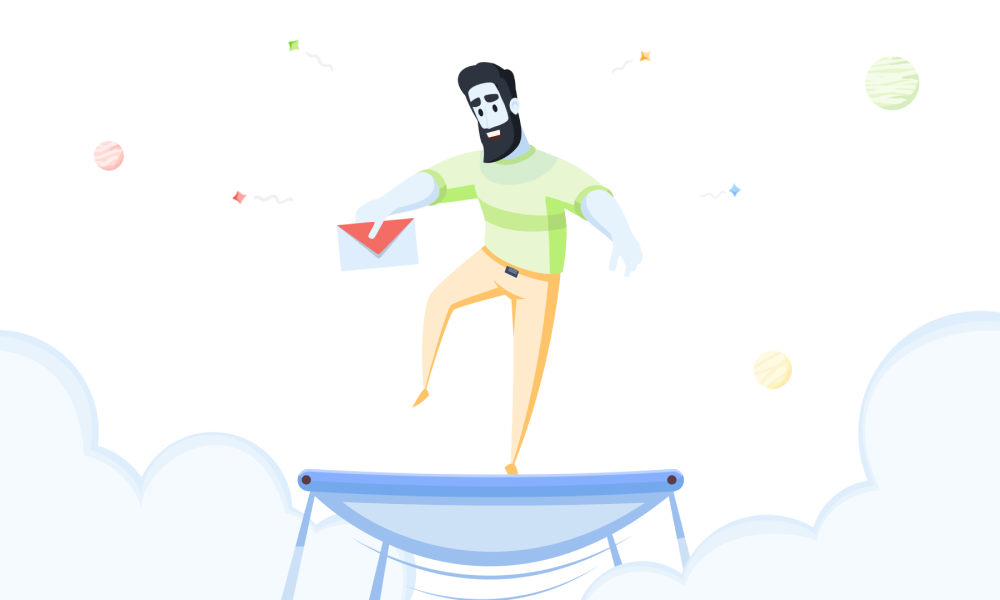Suppose you have not been able to reduce your email bounce rate to within the acceptable range. Then this will cause a nightmare for your entire email marketing campaign. Email bounce is a crucial matter. Now or then, every email marketer has to face an email bounce issue. So, do not underestimate the essentiality of understanding the reason behind it. The email bounce factor is directly related to your email deliverability rate. As a result, each email marketer should be concerned about the email bounce rate.
Email bounce rate
An email bounce occurs when an email gets returned to the marketer (you) from your subscriber’s email server as it could not be delivered. Email bounce happens due to some reasons. However, the term ’email bounce rate’ means the percentage of those bounce-back emails. One can calculate the bounce rate manually, which is a time-consuming process. Here, any email marketing tool can be your best buddy.
Types of Email bounce
There are two types of email bounce, such as –
- Soft bounce.
- Hard bounce.

Soft bounce: Soft bounce refers to a temporary problem. That’s why it is a quick bounce that can be fixable. You can have a chance to solve the issue in terms of soft bounce. Additionally, soft bounce indicates that the receiver’s email address is valid. But the mail didn’t make out to deliver finally for several causes. such –
- The receiver’s inbox is full.
- The receiving server is down, unavailable, or in maintenance.
- The email is too large with unnecessary elements.
Hard bounce: This type is critical, referring to a permanent problem. That’s why the hard bounce problem is not repairable but preventable. In this case, you need to remove that subscriber address from your email list. A hard bounce indicates a big issue with the receiver’s email address or server. Here are the main factors for the hard bounce issue –
- The email sends to an invalid email address.
- The domain name doesn’t exist.
- The email address is incorrect.
- The receiving server block your email, domain, or IP address.
Reasons behind the Email bounce
Here are a few more fundamental reasons indirectly responsible for the bounce-back email. They are –
Blocklisted emails
An email blacklist (blocklist) is one of the common reasons behind the email bouse issue. But it is good to know the sources of the email blocklist database before knowing how you may get blocklisted.
Three sources that provide email blocklists:
- From third-party email blocklist services: Some independent organizations exist to create and maintain email blocklist services. Those organizations deliver them to ESP (Email service provider) companies, such as Gmail, Yahoo, etc.
- From ESP company: Sometimes, ESP companies have their dedicated blocklist database.
- From ISP company: ISP (Internet service provider) companies can also have an email blocklist database.
Let’s put all these complicated things in one place. Your email can be blocklisted if:
- Your email address is blocklisted.
- Your IP is blocklisted.
- Your domain is blocklisted.
- The receiver server only allows receiving safelisted senders.
- Your email detects spam upon several spam complaints.
- Your email is full of spammy elements (e.g., your email subject line is like – “Make Free Money $ with one click.”).
Some other issues
If your primary bulk list contains invalid emails. Another uncontrolled reason is that if someone sets an auto-reply feature while going on a vacation. Also, if your email has malicious attachments, it may bounce back in some situations.
Why the email bounce rate is crucial
Email bounce significantly hampers the email deliverability rate. So, the email bounce rate needs to be looked at appropriately. A good marketer should not be careless about monitoring the email bounce rate. Their entire email marketing campaign can be vastly affected if the bounce rate is relatively high. Besides, a consistently high bounce rate is terrible for your reputation.
So, we have to know what is an acceptable email bounce rate. The accepted email bounce rate is 2% or even better if less than 2%. The 2% rate means two emails are returned for every 100 emails you send to your subscribers. Also, it is okay if the bounce rate is less than 5%. But, If the bounce rate goes up than 5% for your email marketing campaign. Then it is alarming and suggests that you have a significant problem that you should resolve.
However, the fact is manually monitoring your email bounce rate is quite challenging when you are a bulk email sender. So to get your bulk email campaign results quickly. You can use an email marketing tool.
Ways to reduce email bounce rate
If you find your email bounce rate above the acceptable level, then this part is for you. Here are some must-do ways to reduce your email bounce rate.
Choose the correct Email Opt-In method
The Double Opt-In form is strictly required to reduce your email bounce rate if it is already high. Before knowing why it is needed, you must know the other Email Opt-In’s drawbacks. In most cases, those who have a high email bounce rate. They are using the Single Opt-In method. In the Single Opt-In procedure, you didn’t take permission from your visitor/subscriber to send email campaigns to them. When anyone takes your service or visits your webpage, you collect and add their email address to your primary list. Although, this method helps you to make your subscriber list fast. But then your email list will not be hygienic. Many of your visitors/subscribers don’t even want promotional emails from you as they don’t permit you. As a result, they block your email or report it as spam.
With the Double Opt-In method, you can get permission from your visitor/subscriber before sending an email campaign. It is a two-step confirmation process. However, it will not allow you to make an email list quickly. But your created list will be hygiene. In the Double Opt-In method, you can get the green signal from your subscriber. You can provide the process to your subscribers with either a landing page (the best way) or a pop-up. After reading all the terms and conditions, your subscriber will willingly confirm their subscription and allow you to send them your campaign email. As a consequence, your email bounce rate will reduce gradually.
Avoid the email blocklist problem
To prevent the email blocklisting issue, you should consider these points –
- First, you must check your email or domain address to see whether it was already on a block list. It would be best to use an email blocklist checker tool to confirm it. Even if you are not as blocklisted, you should check it frequently.
- Now, if you are blocklisted, with time, you may become a whitelist after a certain period. But it is a time-consuming process. Also, a big problem if you are an email marketer.
- You may contact the blocklist holder’s website to request them to be delisted.
- After facing any hard bounce issues, re-check your primary email list. You have to remove all dead-end addresses from your list. Also, you’ll need to keep monitoring your email list. You should constantly update your subscriber email list by removing invalid or inactive email addresses.
- Always avoid purchasing any email list from anyone. Try to make it organically.
- Always avoid frequent spam issues in terms of email marketing. You may check out this blog to get the ultimate guide on minimizing the email spam problem.
- Suppose your network IP address is on the block list. It’s way easier and more effective to change your ISP.
Additional tips: Blocklists are scary, but they are not forever. It’s better to avoid getting blocklisted from the very first one. Most of the time, blocklist issues arise using a shared/public IP address. So, when you want to execute bulk email marketing. It’s highly preferable to use a domain with a dedicated IP address.
Some more ways
Here are some more required strategies to reduce the email bounce rate. –
- Before sending an email to your subscriber, you must cross-check your email list. It will reduce the chance of email address typo mistakes.
- Maintain connection with your subscribers regularly and consistently. But do not email your subscriber excessively. Excessive email can sometimes make your subscriber’s mailbox full. As a result, your receiver ESP may list you on its blocklist.
- Avoid unnecessary elements or add-ons in your email body. It will make your email colossal. Moreover, make your email subject line relevant and realistic. It would be best to avoid spammy keywords on your email subject line.
- Always run your new campaign with the seed list test process. It will help you know whether your receiver server is down or active. Because, in this test phase, the email bounced back several times from a specific subscriber’s email. It indicates that the subscriber’s email is down.
- Segmenting email is a powerful term in email marketing. Segmenting email assists you in listing your subscribers according to their demography and needs. When your subscribers get relevant emails from you, then the chance of being blocked will be less. As a result, receiver ESP will detect you as a good content provider. Visit this blog to get the most straightforward understanding of email segmentation.
- To maintain your email bounce issue, you should keep a keen eye on your email deliverability rate. If your email deliverability rate remains low, you will get a higher bounce rate.
Conclusion
You will become a great email marketer when you maintain a low bounce rate. Because a high bounce rate quickly degrades your email deliverability. As an email marketer, earning your subscriber’s trust is very important. So, by following the above guidelines, you may lower your email bounce rate. Furthermore, using an email marketing tool such as MailBluster to track your email bounce rate is strongly advised.




 Contents
Contents
